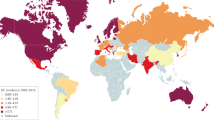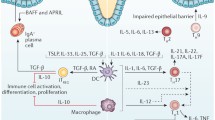Abstract
Introduction
According to the current paradigm both ulcerative colitis (UC) and Crohn’s disease (CD) result from a complex interplay of genetic susceptibility factors, environmental factors, alterations of the physiological intestinal flora and a defective regulation of the intestinal immune system.
Discussion
The objective of this review is to give an overview of these factors and mechanisms, including genetic, environmental and microbial factors, with special alterations of relevant cellular components of the intestinal immune system such as T cells, macrophages and epithelial cells will then be addressed. In addition, the most relevant animal model systems that have contributed to our current pathogenetic understanding will be introduced. Clinically, the natural course of UC with special reference to the risk of colorectal cancer will be addressed.
Conclusion
The elucidation of pathomechanisms at the level of the intestinal immune system provides the potential for novel, effective treatment strategies. Best surgical management of patients with UC, however, still remains a challenge.


Similar content being viewed by others
References
Orholm M, et al (1991) Familial occurrence of inflammatory bowel disease. N Engl J Med 324:84–88
Satsangi J, et al (1996) Contribution of genes of the major histocompatibility complex to susceptibility and disease phenotype in inflammatory bowel disease. Lancet 347:1212–1217
Futami S, et al (1995) HLA-DRB1*1502 allele, subtype of DR15, is associated with susceptibility to ulcerative colitis and its progression. Dig Dis Sci 40:814–818
Orchard TR, et al (2000) Clinical phenotype is related to HLA genotype in the peripheral arthropathies of inflammatory bowel disease. Gastroenterology 118:274–278
Saxon A, et al (1990) A distinct subset of antineutrophil cytoplasmic antibodies is associated with inflammatory bowel disease. J Allergy Clin Immunol 86:202–210
Duerr RH, et al (1991) Anti-neutrophil cytoplasmic antibodies in ulcerative colitis. Comparison with other colitides/diarrheal illnesses. Gastroenterology 100:1590–1596
Sandborn WJ, et al (1995) Antineutrophil cytoplasmic antibody correlates with chronic pouchitis after ileal pouch–anal anastomosis. Am J Gastroenterol 90:740–747
Sandborn WJ, et al (1996) Association of antineutrophil cytoplasmic antibodies with resistance to treatment of left-sided ulcerative colitis: results of a pilot study. Mayo Clin Proc 71:431–436
Papo M, et al (1996) Antineutrophil cytoplasmic antibodies in relatives of patients with inflammatory bowel disease. Am J Gastroenterol 91:1512–1515
Cohavy O, et al (2000) Colonic bacteria express an ulcerative colitis pANCA-related protein epitope. Infect Immun 68:1542–1548
Bhagat S, Das KM (1994) A shared and unique peptide in the human colon, eye, and joint detected by a monoclonal antibody. Gastroenterology 107:103–108
Vashishtha A, Fischetti VA (1993) Surface-exposed conserved region of the streptococcal M protein induces antibodies cross-reactive with denatured forms of myosin. J Immunol 150:4693–4701
Thomas GA, et al (2000) Role of smoking in inflammatory bowel disease: implications for therapy. Postgrad Med J 76:273–279
Lindberg E, et al (1988) Smoking and inflammatory bowel disease. A case control study. Gut 29:352–357
Miller LG, et al (1982) Reversible alterations in immunoregulatory T cells in smoking. Analysis by monoclonal antibodies and flow cytometry. Chest 82:526–529
Srivastava ED, et al (1991) Smoking, humoral immunity, and ulcerative colitis. Gut 32:1016–1019
Cope GF, Heatley RV, Kelleher JK (1986) Smoking and colonic mucus in ulcerative colitis. BMJ 293:481
Sher ME, et al (1999) The influence of cigarette smoking on cytokine levels in patients with inflammatory bowel disease. Inflamm Bowel Dis 5:73–78
Madretsma S, et al (1996) In-vivo effect of nicotine on cytokine production by human non-adherent mononuclear cells. Eur J Gastroenterol Hepatol 8:1017–1020
Evans JM, et al (1997) Non-steroidal anti-inflammatory drugs are associated with emergency admission to hospital for colitis due to inflammatory bowel disease. Gut 40:619–622
McCartney SA, et al (1999) Selective COX-2 inhibitors and human inflammatory bowel disease. Aliment Pharmacol Ther 13:1115–1117
Herbert TB, Cohen S (1993) Stress and immunity in humans: a meta-analytic review. Psychosom Med 55:364–379
Levenstein S, et al (2000) Stress and exacerbation in ulcerative colitis: a prospective study of patients enrolled in remission. Am J Gastroenterol 95:1213–1220
Madara JL, et al (1985) Characterization of spontaneous colitis in cotton-top tamarins (Saguinus oedipus) and its response to sulfasalazine. Gastroenterology 88:13–19
Rutgeerts P, et al (1994) Appendectomy protects against ulcerative colitis. Gastroenterology 106:1251–1253
Andersson RE, et al (2001) Appendectomy and protection against ulcerative colitis. N Engl J Med 344:808–814
Okazaki K, et al (2000) A patient with improvement of ulcerative colitis after appendectomy. Gastroenterology 119:502–506
Mizoguchi A, et al (1996) Role of appendix in the development of inflammatory bowel disease in TCR-alpha mutant mice. J Exp Med 184:707–715
Sartor RB, (1997) Role of the enteric microflora in the pathogenesis of intestinal inflammation and arthritis (review). Aliment Pharmacol Ther 11 [Suppl 3]:17–22, discussion 22–23
Burke DA, Axon AT (1988) Adhesive Escherichia coli in inflammatory bowel disease and infective diarrhoea. BMJ 297:102–104
Walmsley RS, et al (1998) Absence of Escherichia coli, Listeria monocytogenes, and Klebsiella pneumoniae antigens within inflammatory bowel disease tissues. J Clin Pathol 51:657–661
Shanahan F (2000) Mechanisms of immunologic sensation of intestinal contents. Am J Physiol 278:G191–G196
D’Haens GR, et al (1998) Early lesions of recurrent Crohn’s disease caused by infusion of intestinal contents in excluded ileum. Gastroenterology 114:262–267
Sartor RB (1998) Postoperative recurrence of Crohn’s disease: the enemy is within the fecal stream. Gastroenterology 114:398–407
Turunen UM, et al (1998) Long-term treatment of ulcerative colitis with ciprofloxacin: a prospective, double-blind, placebo-controlled study. Gastroenterology 115:1072–1078
Shen B, et al (2001) A randomized clinical trial of ciprofloxacin and metronidazole to treat acute pouchitis. Inflamm Bowel Dis 7:301–305
Rembacken BJ, et al (1999) Non-pathogenic Escherichia coli versus mesalazine for the treatment of ulcerative colitis: a randomised trial. Lancet 354:635–639
Kruis W, Fric P, Stolte M (2001) Maintenance of remission in ulcerative colitis is equally effective with Escherichia coli Nissle 1917 and standard mesalamine. Gastroenterology 120:A127 [Suppl]
Gionchetti P, et al (2000) Oral bacteriotherapy as maintenance treatment in patients with chronic pouchitis: a double-blind, placebo-controlled trial. Gastroenterology 119:305–309
Qiao L, et al (1991) Activation and signaling status of human lamina propria T lymphocytes. Gastroenterology 101:1529–1536
Targan SR, et al (1995) Definition of a lamina propria T cell responsive state. Enhanced cytokine responsiveness of T cells stimulated through the CD2 pathway. J Immunol 154:664–675
Braunstein J, et al (1997) T cells of the human intestinal lamina propria are high producers of interleukin-10. Gut 41:215–220
Boirivant M, et al (1996) Stimulated human lamina propria T cells manifest enhanced Fas-mediated apoptosis. J Clin Invest 98:2616–2622
Ayabe T, et al (1997) A pilot study of centrifugal leukocyte apheresis for corticosteroid-resistant active ulcerative colitis. Intern Med 36:322–326
Hanai H, et al (2002) Granulocyte and monocyte adsorption apheresis in patients with severe corticosteroid unresponsive ulcerative colitis. Gastroenterol T1187:A-431
Kawamura N, et al (2002) Efficacy of leucocyte apheresis with the use of nonwoven polyester filter in ulcerative colitis. Gastroenterol T1196:A-431
Stumbles P, Mc William A, Holt P (1999) Dendritic cells and mucosal macrophages. In: Ogra PL, Bienenstock I, Strober W (eds) Mucosal immunology. Academic Press, San Diego
Casini-Raggi V, et al (1995) Mucosal imbalance of IL-1 and IL-1 receptor antagonist in inflammatory bowel disease. A novel mechanism of chronic intestinal inflammation. J Immunol 154:2434–2440
Monteleone G, et al (1997) Interleukin 12 is expressed and actively released by Crohn’s disease intestinal lamina propria mononuclear cells. Gastroenterology 112:1169–1178
Christ AD, et al (1998) An interleukin 12-related cytokine is up-regulated in ulcerative colitis but not in Crohn’s disease. Gastroenterology 115:307–313
Auphan N, et al (1995) Immunosuppression by glucocorticoids: inhibition of NF-kappa B activity through induction of I kappa B synthesis. Science 270:286–290
Weber CK, et al (2000) Suppression of NF-kappaB activity by sulfasalazine is mediated by direct inhibition of IkappaB kinases alpha and beta. Gastroenterology 119:1209–1218
Dubuquoy L, et al (2003) Impaired expression of peroxisome proliferator-activated receptor gamma in ulcerative colitis. Gastroenterology 124:1265–1276
Lewis JD, et al (2001) An open-label trial of the PPAR-gamma ligand rosiglitazone for active ulcerative colitis. Am J Gastroenterol 96:3323–3328
Autschbach F, et al (1995) Cytokine messenger RNA expression and proliferation status of intestinal mononuclear cells in noninflamed gut and Crohn’s disease. Virchows Arch 426:51–60
Watanabe M, et al (1995) Interleukin 7 is produced by human intestinal epithelial cells and regulates the proliferation of intestinal mucosal lymphocytes. J Clin Invest 95:2945–2953
Elson CO, et al (1995) Experimental models of inflammatory bowel disease. Gastroenterology 109:1344–1367
Boirivant M, et al (1998) Oxazolone colitis: a murine model of T helper cell type 2 colitis treatable with antibodies to interleukin 4. J Exp Med 188
Mombaerts P, et al (1993) Spontaneous development of inflammatory bowel disease in T cell receptor mutant mice. Cell 75:274–282
Sadlack B, et al (1993) Ulcerative colitis-like disease in mice with a disrupted interleukin-2 gene. Cell 75:253–261
Watanabe M, et al (1995) Interleukin 7 is produced by human intestinal epithelial cells and regulates the proliferation of intestinal mucosal lymphocytes. Clin Invest 95:2945–2953
Heller F, et al (2002) Oxazolone colitis, a Th2 colitis model resembling ulcerative colitis, is mediated by IL-13-producing NK-T cells. Immunity 17:629–638
Mizoguchi E, et al (1997) Antineutrophil cytoplasmic antibodies in T-cell receptor alpha-deficient mice with chronic colitis. Gastroenterology 113:1828–1835
Lichtiger S, et al (1994) Cyclosporine in severe ulcerative colitis refractory to steroid therapy. N Engl J Med 330:1841–1845
Watanabe M, et al (1998) Interleukin 7 transgenic mice develop chronic colitis with decreased interleukin 7 protein accumulation in the colonic mucosa. J Exp Med 187:389–402
Holtmann MH, Galle PR (2003) Therapy-refractory and fulminant, toxic colitis. Dig Surg 20:372–374
Mourelle M, et al (1995) Induction of nitric oxide synthase in colonic smooth muscle from patients with toxic megacolon. Gastroenterology 109:1497
Mourelle M, et al (1996) Toxic dilatation of colon in a rat model of colitis is linked to an inducible form of nitric oxide synthase. Am J Physiol 33:G425
Caprilli R, et al (1987) Early recognition of toxic megacolon. J Clin Gastroenterol 9:136
Strauss RJ, et al (1976) The surgical management of toxic dilatation of the colon: a report of 28 cases and a review of the literature. Ann Surg 184:682
Danovitch SH (1989) Fulminant colitis and toxic megacolon. Gastroenterol Clin North Am 18:73
Hendrikson C, Kreiner S, Binder V (1985) Long term prognosis in ulcerative colitis—based on results from a regional patient group from the country of Copenhagen. Gut 26:158–163
Langholz E, Munkholm P, Davidson M (1994) Course of ulcerative colitis: analysis of changes in disease activity over years. Gastroenterology 107:3–11
Bernstein CN, et al (2001) Cancer risk in patients with inflammatory bowel disease. Cancer 48:526–535
Eaden JA, Abrams KR, Mayberry JF (2001) The risk of colorectal cancer in ulcerative colitis. a meta-analysis. Gut 48:526–535
Loftus EV (2003) Does monitoring prevent cancer in inflammatory bowel disease? J Clin Gastroenterol 36[Suppl 1]:S79–S83
Schlemper RJ, et al (2000) The Vienna classification of gastrointestinal epithelial neoplasia. Gut 47:251–255
Riddell RH, et al (1983) Dysplasia in inflammatory bowel disease. Standardized classification with provisional clinical applications. Hum Pathol 14:931–968
Blackstone MO, et al (1981) Dysplasia-associated lesion or mass (DALM) detected by colonoscopy in long-standing ulcerative colitis: an indication for colectomy. Gastroenterology 80:366–374
Bernstein CN, Shanahan F, Weinstein WM (1994) Are we telling patients the truth about surveillance colonoscopy in ulcerative colitis? Lancet 343:71–74
Provenzale D, Onken J (2001) Surveillance issues in inflammatory bowel disease: ulcerative colitis. J Clin Gastroenterol 32:99–105
Tanaka S, et al (2000) Detailed colonoscopy for detecting early superficial carcinoma; recent developments. J Gastroenterol 35 [Suppl 12]:121–125
Kiesslich R, et al (2003) Methylene blue-aided chromoendoscopy for the detection of intraepithelial neoplasia and colon cancer in ulcerative colitis. Gastroenterology 124:880–888
Author information
Authors and Affiliations
Corresponding author
Rights and permissions
About this article
Cite this article
Holtmann, M.H., Galle, P.R. Current concept of pathophysiological understanding and natural course of ulcerative colitis. Langenbecks Arch Surg 389, 341–349 (2004). https://doi.org/10.1007/s00423-003-0448-5
Received:
Accepted:
Published:
Issue Date:
DOI: https://doi.org/10.1007/s00423-003-0448-5




